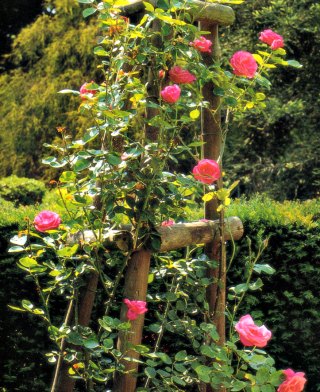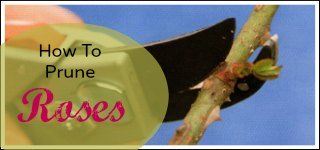Pruning Climbing Roses
Once-Flowering or Repeat-Flowering Climbers? It is essential for pruning climbing roses to know the flowering habit of the variety
Most climbing roses need little or no pruning during the first two, three years of growing. That will allow them to develop several long arching canes.
When it comes to pruning, we have to distinguish between two types of climbers:
Regardless of the flowering type, first remove all dead, diseased and damaged wood. Cut away any canes growing away from the structure that cannot be tied back.
Any crossing or awkwardly placed canes should be removed too.
Then try to get rid of as much as foliage as possible. This allows you to see the rose’s branching structure much easier and reduces the risk of disease spores being carried over.
Pruning Climbing Roses - How To Identify The Flowers

When you buy climbing roses it is necessary to know to which type your new purchase belongs.
Later in an established garden with several roses, you always should know what type of bloomer you have planted in which place.
Some private gardens have more than hundred rose varieties and without a guide or tags on the flowers, you can easily lose track where which rose grows.
To draw a sketch or put a tag on the flowers, will help you identify the roses in your garden exactly.
Even experts sometimes struggle to distinguish among so many rose varieties and once you have to prune them, it is very useful to know with which type you have to work.
Pruning Once-Flowering Climbing Roses
Once-flowering varieties form blossoms mainly on one-year-old wood. If you cut them in the spring, you take away the best blooming wood. Therefore, in the spring only a basic pruning (dead, diseased and damaged wood) takes place.
Once-blooming varieties are best pruned in summer in full leaf after the flowering has finished.
As an ideal goal, the rose should preferably have only young shoots.
If the plant has formed enough 1-year old canes...
- Remove all shoots that produced blooms at their base right at the bud union or at the main cane
- Cut all weak and insufficient developed shoots
- If there are laterals on the 1-year old canes, cut them at the base. At these areas, blossoms will form in the coming year
If the plant has developed to less 1-year old canes...
- Leave 1-2 year-old canes
- Cut the laterals on these canes to 2-3 bud eyes
- Remove weak canes 1/6 inch above their base
- Do not leave any stubs and do not cut shoot-ends
- Remove these now 3-years old canes after the flowering flush of the coming year
Pruning Repeat-Flowering Climbing Roses
Unlike the once-flowering climbing roses, the repeat-flowering varieties primarily form buds on two-year-old and perennial canes with many laterals.
Repeat-blooming climbers are pruned in spring. To ensure an annually repeating floweriness, you have to keep canes of all ages.
To achieve a vigorous blooming we have to do the following work...
- Try to keep canes of different ages: When pruning, remove one or two of the old canes, perhaps at the base. That will make it possible for young shoots to grow from there. The plant will remain young and viable.
- The young canes must not be pruned; only the laterals will be removed
- Shoots ends must not be cut
- At the main canes, laterals are pruned up to 2-3 bud eyes
- Remove weak canes 1/6 inch above their base
Weak shoots, less than a pencil in diameter, should always be removed during the growing season, to keep the plant strong and tidy.
During the summer, dead-head as the flowers fade, to encourage second flowering. Cut back to the nearest leaf.
The removal of redundant and weak shoots during the summer ensures that they do not take energy from the climbing roses.
Watch this helpful video about pruning and controlling a climbing rose














New! Comments
Have your say about what you just read! Leave me a comment in the box below.